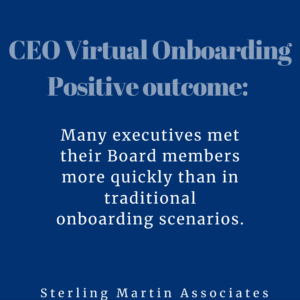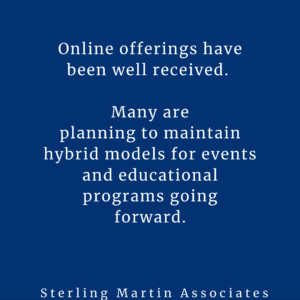CEO Virtual Onboarding
SMA CEO and Managing Partner David Martin recently hosted an informal chat about the virtual onboarding experience with many of the Executive Directors and CEOs that SMA placed last year. They swapped stories about getting to know Board members via Zoom and creating new virtual event programs based around technologies adopted in 2020.
New executives always have a steep learning curve. The situations these individuals faced, though, called for even more accelerated onboarding processes and heightened levels of creativity and flexibility. Their experiences with virtual onboarding provide valuable insights for other executives who are coming on board at a time when their staff members are working remotely.
Meeting Board and Staff Members
A small number of executives said they’d been regularly working in their organizations’ offices. Some had had the opportunity to meet individual Board members in person, and others had been able to organize one-on-one meetings with senior staff. By and large, though, new executives said they were relying on videoconferencing to connect with their new Board and staff members.
 One positive outcome that most noted was that they were able to meet Board members much more quickly than in more traditional onboarding scenarios (e.g., when an executive would have waited until the next conference or event to meet the Board). Most 2020 SMA placements said they were able to have one-on-one meetings with all of their Board members within their first month on the job.
One positive outcome that most noted was that they were able to meet Board members much more quickly than in more traditional onboarding scenarios (e.g., when an executive would have waited until the next conference or event to meet the Board). Most 2020 SMA placements said they were able to have one-on-one meetings with all of their Board members within their first month on the job.
Some executives took a similar approach to meeting their new staff members, scheduling one-on-one calls for their first weeks in the role. Others took a more casual approach, reaching out to staff members on an informal basis and setting up impromptu calls or virtual coffee chats when schedules allowed.
Connecting with Members
Few SMA placements were able to participate in an in-person annual meeting or other event this year, and none are able to predict when their organizations will host their next in-person gatherings. Without a scheduled event where a new CEO or ED can meet the membership, organizations have looked for creative ways to handle the introductions.
Some executives with smaller organizations have scheduled one-on-one calls with their members. Larger organizations are hosting virtual happy hours or coffee chats where members can join informal discussions. Some are planning more structured events where new executives can engage in facilitated discussions with members.
Running a Remote Organization
At the same time they’ve been meeting their new teams and learning their new organizations, CEOs and EDs have been faced with concerns over how to ensure accountability while remote work continues. Without established relationships with team members—and while still developing an understanding of their organizations and how they run—new executives have found it challenging to navigate these discussions and determine the best path forward.
Several also noted that they’re faced with coordinating their first rounds of performance reviews. Even those organizations with well-established processes are reconsidering how these have been done in the past and whether those approaches need to be adjusted based on the current circumstances.
Mitigating the Pandemic’s Impact
 All organizations have felt the financial and operational impact of the pandemic. Associations and nonprofits have been most noticeably affected by the cancellation of their annual conferences and educational events. New executives discussed how their teams had transitioned to virtual meetings, and most reported positive experiences for their speakers and attendees. Online programming was generally well received, and many executives said they plan to maintain a hybrid model for events and educational programs going forward.
All organizations have felt the financial and operational impact of the pandemic. Associations and nonprofits have been most noticeably affected by the cancellation of their annual conferences and educational events. New executives discussed how their teams had transitioned to virtual meetings, and most reported positive experiences for their speakers and attendees. Online programming was generally well received, and many executives said they plan to maintain a hybrid model for events and educational programs going forward.
Organizations that had large expos or exhibit halls reported greater challenges, though. None had found a virtual platform that had been able to replicate the in-person experience. Vendors had noted that their sponsorship dollars didn’t generate the same levels of engagement as had been seen at in-person events.
Beyond events, CEOs and EDs discussed the pandemic’s impact on membership renewals and other revenue streams. A small number had had to lay off staff as a result of the pandemic, but others had been able to hire additional team members. Across the board, all executives had had to adjust their budgets and spending in response to the crisis.
Looking Ahead
SMA’s 2020 placements are cautiously beginning to look beyond the pandemic. They’re starting to discuss what it will look like when staff return to their offices, and they’re starting to consider when they might schedule their first in-person meetings. They’re also looking for ways they can carry some of the positive outcomes from 2020—new technologies, more flexible working arrangements, and hybrid event models—forward and make them part of their ongoing operations.

